Fermenting Beer with Wyeast 1056 American Ale Yeast
Published: October 2, 2025 at 5:36:23 PM UTC
This article serves as a practical guide for homebrewers in the United States. It focuses on achieving reliable results with Wyeast 1056 American Ale Yeast. The guide is written in clear, actionable terms, blending lab-style metrics with practical kitchen-brewroom advice.
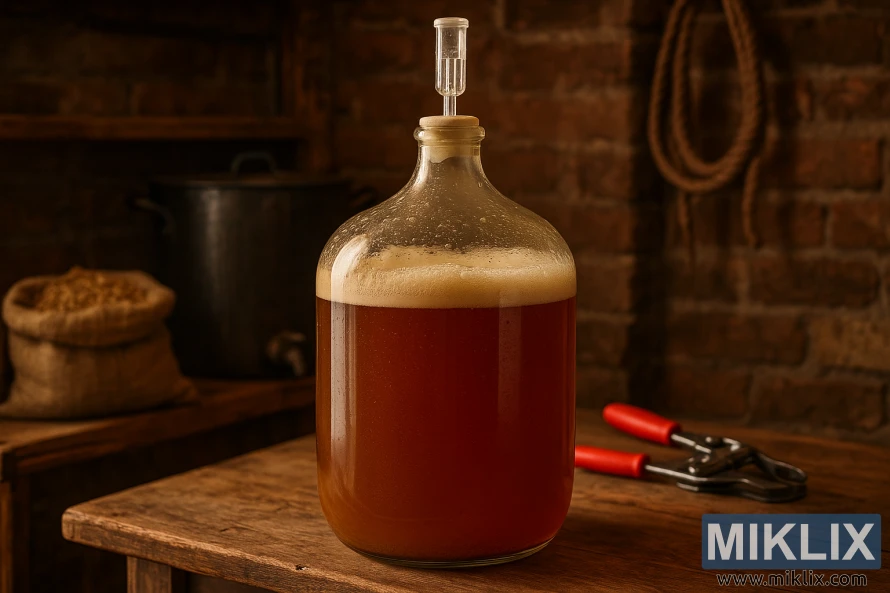
Wyeast 1056 is celebrated for its clean, versatile nature. It enhances malt and hop flavors while minimizing fruitiness and ester production. We will examine its medium-low flocculation, 73–77% attenuation, and a temperature range of 60–72°F (15–22°C). It also has an alcohol tolerance near 11% ABV.
Targeted at homebrewers seeking a dependable American ale yeast for various styles, this guide is invaluable. Whether you're refining your house strain or selecting a new yeast, the insights on Wyeast 1056 aim to be practical and repeatable for your brewing endeavors.
Key Takeaways
- Wyeast 1056 American Ale Yeast is a clean, versatile strain that emphasizes malt and hop clarity.
- Typical metrics: 73–77% attenuation, medium-low flocculation, temp range 60–72°F, ~11% ABV tolerance.
- Guide combines fermenting with 1056 best practices and comparative notes versus Chico strains and US-05.
- Focus areas include starters, pitch rates, temperature control, oxygenation, and troubleshooting.
- Designed for U.S. homebrewers aiming for reliable results in pale ales, IPAs, ambers, and stouts.
Why Choose Wyeast 1056 American Ale Yeast for Your Homebrews
Wyeast 1056 is celebrated for its clean, crisp taste. It allows malt and hops to shine. Brewers often choose it for its minimal fruity esters and neutral background.
The yeast's benefits include reliable attenuation of 73–77% and medium-low flocculation. These characteristics ensure consistent finishing gravity and head retention in every batch.
Its temperature flexibility is another key advantage. Fermenting between 60–72°F produces excellent results. Cooler temperatures, around 60–66°F, enhance the flavor with mild citrus notes.
Its versatility makes it a favorite house strain for many brewers. Wyeast 1056 is suitable for a wide range of beers, including American Pale Ale, IPA, Amber Ale, Brown Ale, Stout, Porter, cream ales, and wood-aged beers.
Opt for this yeast if you seek consistency and a neutral base for your brews. Small adjustments in pitch and temperature lead to predictable outcomes without unexpected esters.
- Why use Wyeast 1056: neutral flavor, high versatility
- Benefits of 1056: steady attenuation and dependable finishing
- Clean fermenting yeast: ideal for ingredient-forward recipes
- House strain value: consistent batch-to-batch performance
Understanding Wyeast 1056 American Ale Yeast: Strain Characteristics
The Wyeast 1056 profile is rooted in the Chico/American ale lineage, celebrated for its clean fermentation. It's the go-to yeast for brewers aiming to showcase hops and malt without the dominance of yeast flavors.
Its key characteristics include a clean, crisp taste with minimal fruitiness and mild esters. This makes it ideal for pale ales, IPAs, and malt-forward beers. Clarity in hop and grain notes is a priority here.
Attenuation and flocculation of the 1056 strain fall in a moderate range. Attenuation is typically around 73–77 percent, leading to a dry finish. This supports hoppy beers and stronger ales well.
Flocculation is medium-low, meaning the yeast stays suspended longer. Brewers often use longer conditioning or filtration to achieve the desired clarity.
The ideal temperature range for fermentation is 60 to 72°F (15–22°C). Fermenting at 60–66°F enhances clean esters and mild citrus. Temperatures closer to 70–72°F can introduce subtle estery or phenolic notes.
Wyeast 1056 can tolerate alcohol up to about 11% ABV. This makes it suitable for imperial styles and high-gravity batches, provided pitch rate and nutrients are managed. Its alcohol tolerance aligns with its steady attenuation and controlled flavor production.
Practical brewing tips for 1056 include pitching a healthy cell count and maintaining fermentation temperatures within the recommended range. Also, plan for extra cold conditioning if achieving clarity is a priority.
Grasping the Wyeast 1056 profile empowers brewers to craft beers where hops and malt take center stage. This is achieved through predictable attenuation and flocculation behavior, influencing mouthfeel and clarity.
Ideal Beer Styles to Ferment with Wyeast 1056
Wyeast 1056 excels in beers requiring a clean, neutral yeast profile. It's perfect for American Pale Ale, American IPA, and Imperial IPA. These styles benefit from its crisp attenuation and minimal ester production, allowing hop aromas to dominate.
For beers with a focus on malt, consider American Amber Ale, American Brown Ale, and American Stout. The best beers with Wyeast 1056 often include brown porter and dry stout recipes. These showcase roasted and caramel malts without yeast interference.
Stronger, malt-forward brews like American Barleywine and Russian Imperial Stout also thrive with 1056. It supports high-gravity fermentations while keeping esters in check. Many wood-aged beers benefit from 1056, as it preserves the distinctness of oak and barrel notes.
1056 is ideal for seasonal or spiced beers where adjunct flavors should shine. Cream Ale and Irish Red Ale demonstrate its ability to maintain delicate malt balance and consistent attenuation. This makes it a reliable choice for brewers.
This yeast is versatile and predictable, making it a great choice for a house yeast. It excels in Scottish-inspired malty ales and hop-forward modern styles. Clarity of bitterness and aroma is key in these styles.
- Hop-forward: American IPA, Imperial IPA
- Balanced malty: American Amber, Irish Red Ale
- Roasty/dark: American Stout, Brown Porter, Russian Imperial Stout
- Specialty: Wood-aged beers, spiced and seasonal ales
When crafting 1056 recipe ideas, focus on mash and fermentation practices that support neutrality. Maintain consistent fermentation temperatures to preserve the yeast's clean character. Brewers often choose 1056 for its reliability in producing consistent, high-quality beers.
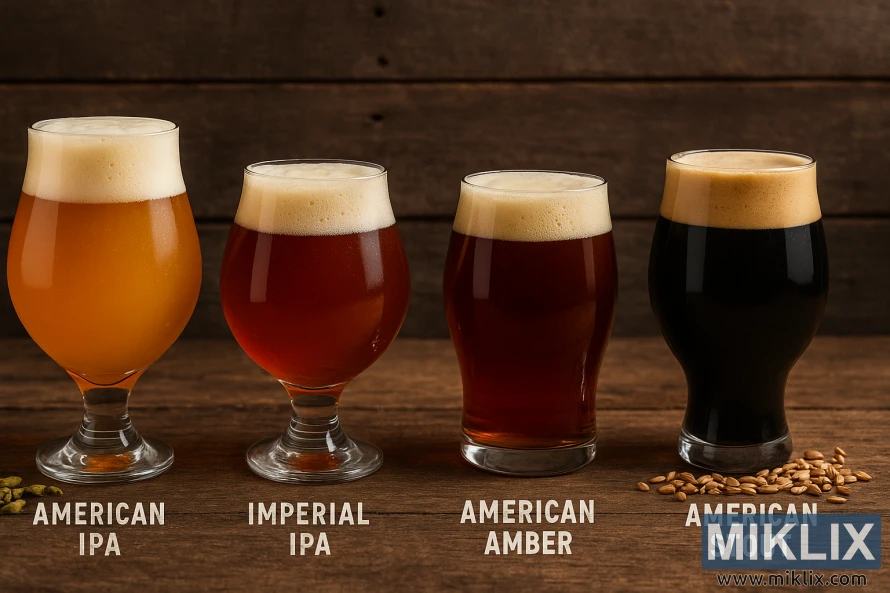
Preparing the Yeast: Slurry, Smack Pack, and Starter Best Practices
Begin by determining the size of your Wyeast 1056 starter based on your beer's volume. The goal is to increase the cell count for a healthy pitch. For high-gravity beers, use a pitch rate calculator to figure out the starter volume and yeast age.
Ensure you allow sufficient time for the starter to grow. Aim for 2–4 days, with 3–4 days being a common target. This allows for cold crashing and decanting before pitching.
While step-ups can be beneficial, keep them simple. Staging your starter, like two 650 ml increases, is useful for high cell counts. Yet, avoid over-transferring to prevent contamination. A single, well-sized starter is often safer.
Consider the source of your yeast. For high-gravity beers, Wyeast liquid packs benefit from a healthy starter. Dry yeast alternatives, such as SafAle US-05, can be rehydrated for quicker lag times.
Rehydrating dry yeast can significantly reduce lag times. Follow the manufacturer's instructions for rehydration and use warm water. This helps yeast cells recover and start fermentation faster.
When harvesting and repitching yeast, do so with care. Liquid yeast slurry can be reused if handled properly. Wyeast 1056 repitches well if you maintain cleanliness and avoid oxygen exposure during harvesting.
Choose the right equipment for your starters. Many prefer foam stoppers over sealed airlocks. Foam stoppers allow gas exchange, preventing an anaerobic environment that hinders growth.
Monitor the starter's gravity and temperature closely. Aim for a moderate gravity to encourage cell reproduction over flavor production. Keep the starter warmer than the fermentation temperature to promote cell growth without stressing the yeast.
Adopt basic yeast starter tips to minimize issues. Pitch fresh yeast, sanitize thoroughly, and cool before decanting. These practices will help maximize viable cell count and reduce contamination risk.
Pitch Rates and Scaling for Different Batch Sizes
Calculating pitch rates is straightforward. It involves matching yeast cell count to batch volume and original gravity. For a 5-gallon ale with an OG of 1.050–1.060, use a tool to determine the target cells before creating a starter.
Liquid Wyeast packs often fall short for high-gravity beers. For such brews, plan a starter or combine multiple packs. This is essential for larger volumes or split batches. Scaling starter sizes becomes more critical for 10-gallon or bigger brews than for a single 5-gallon batch.
Many brewers prefer dry strains for their quick and reliable fermentation. For pitching yeast in 5-gallon batches, two packs of a quality dry yeast like SafAle US-05 are a common choice. This combination speeds up lag time and ensures a strong fermentation start.
- A single well-sized starter usually covers most 5-gallon ales.
- Avoid overbuilding starters; extra step-ups raise contamination risk.
When reusing harvested slurry, check yeast health and generation count. Healthy slurry can reduce the need for new starters and maintain consistent performance across batches.
Keep detailed records of pitch rates, starter sizes, and outcomes. This log will help refine your approach to 1056 pitch rates. It will also teach you how to scale starter sizes for larger or stronger beers.
Fermentation Temperature Control and Its Impact on Flavor
Wyeast 1056 thrives within the 60–72°F (15–22°C) range recommended by the manufacturer. Keeping temperatures between 60–66°F ensures a clean flavor with hints of citrus. Moving towards the upper end of this range can enhance fruitiness from yeast.
For those aiming to manage fermentation flavors, it's essential to monitor temperatures closely. Avoid sudden, large temperature changes, as they can stress the yeast and amplify off-flavors. Instead, opt for a gradual increase of a few degrees per day for more consistent results.
Reports from the brewing community highlight the impact of temperature on esters. Both the absolute temperature and the rate of change play a role. Warm fermentations or rapid warming towards the end can increase esters, sometimes introducing spicy or phenolic notes.
- For a neutral ale: aim 60–64°F and keep steady.
- For a fruit-forward profile: try 66–70°F with gradual rises.
- For fast ferment finish: avoid abrupt increases to limit harsh esters.
Unwanted esters from Chico strains like US-05 or 1056 can often be mitigated with better temperature control. Small adjustments in fermentation temperature can significantly alter the aroma and taste, as observed in sensory panels.
Implementing practical steps such as using a temperature-controlled fermentation chamber, wrapping fermenters for gentle warming, and daily temperature recording can help. These methods enable precise control of the 1056 fermentation temperature, aligning with your recipe's objectives.
Homebrewing experimentation is key to learning. Start by adjusting one variable at a time, keeping detailed records, and tasting across batches. This approach helps you understand how temperature affects esters and phenolics in your specific setup. Consistent monitoring empowers you to fine-tune fermentation flavors with confidence.
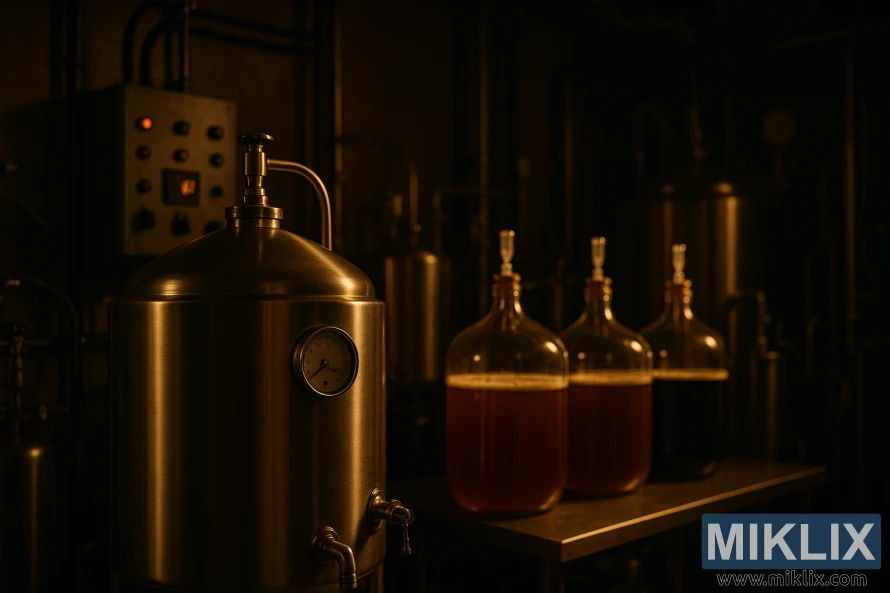
Oxygenation, Aeration, and Lag Time Considerations
Oxygenating wort 1056 before pitching is essential for yeast health. It provides the necessary sterols and unsaturated fatty acids for strong cell walls and rapid growth. For gravities between 1.050–1.060, vigorous shaking or pure oxygen dosing significantly boosts early fermentation activity.
Lag time is influenced by several factors: pitch rate, yeast form, wort oxygenation, temperature, and overall yeast health. Brewers see shorter aeration lag times with healthy starters or when rehydrating dry yeast correctly.
To minimize lag time, focus on pitching adequate cell counts and checking starter activity. Avoid cold shock. For sluggish wet starters, provide extra time or perform a step-up to enhance viability before brewing.
Many homebrewers opt to rehydrate dry yeast to reduce startup delays. Brands like SafAle and Nottingham provide guidelines for rehydration. Following these can improve cell recovery and lower initial stress.
- Low-gravity beers: oxygenating wort 1056 with air may suffice.
- High-gravity beers: consider pure oxygen at measured intervals.
- Dry yeast: rehydrate dry yeast for 10–15 minutes in sterile water at 35–40°C to shorten lag.
Aeration lag time can also be influenced during transfer. Purging fermenters with CO2 while minimizing splashing preserves aroma and controls oxygen uptake. Choose gas-in to beer-out or gas-in to liquid-out methods based on your setup and sanitation comfort.
Monitor lag by tracking gravity and krausen formation in the first 24–48 hours. If activity lags beyond expected windows, check temperature, yeast age, and whether you met target oxygenating wort 1056 levels at pitch.
Managing Fermentation Dynamics: Activity, Krausen, and Timing
Wyeast 1056 typically enters a short lag phase lasting 12–36 hours. Once active, yeast activity and CO2 production surge. Use a hydrometer to track fermentation activity 1056 and confirm progress.
Krausen formation is a key indicator during the active fermentation phase. It follows a consistent timeline in most batches. With medium-low flocculation, krausen persists longer and drops more slowly. While visual cues are helpful, they should not replace gravity checks.
Fermentation timing shifts from intense bubbling to a steady decline over days. Verify attenuation with specific gravity measurements, not just airlock activity. Monitoring fermentation by gravity ensures a precise racking or secondary conditioning time.
- Check gravity at 24–48 hour intervals until readings stabilize over three days.
- Keep pitch rates and temperatures consistent when splitting larger volumes to maintain uniform fermentation timing.
- Use CO2 output as a safety guide when purging kegs and managing oxygen exclusion.
When splitting a 10-gallon batch into two fermentors, match pitch and temps to reduce variance. Good monitoring habits cut surprises and help predict attenuation for ales fermented with 1056.
Record gravity, temperature, and visible krausen notes for each batch. These simple logs improve consistency and refine your understanding of fermentation activity 1056 across recipes and seasons.
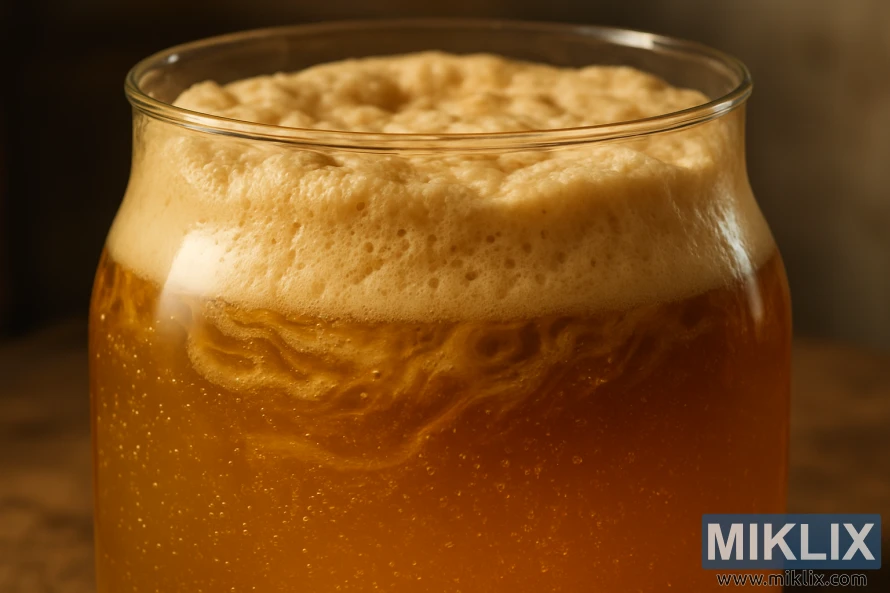
Flocculation, Clarity, and Conditioning for Bright Beers
Wyeast 1056 exhibits medium-low flocculation, which means yeast remains suspended longer. This characteristic often hinders natural clearing. Brewers targeting a bright beer should anticipate additional time or steps.
Cold-conditioning, or a cold crash, accelerates yeast drop-out. It does so by lowering yeast activity and promoting particle settling. Many brewers move their beer to secondary and chill it to near-freezing for days or weeks. This process clarifies beers Wyeast 1056. Gentle racking after conditioning is essential to avoid disturbing the trub layer.
When immediate brightness is required, consider filtration vs conditioning. Filtration offers quick clarity and consistent appearance, ideal for commercial kegs and bottle-conditioned beers for competitions. Conditioning, on the other hand, allows for flavor maturation and preserves delicate aromatics that filtration might strip.
- Allow full fermentation and verify final gravity before transfer.
- Use cold-conditioning for 3–14 days for modest batches; lagering longer for crystal clear results.
- Choose filtration when timeline or presentation demands instant clarity.
Packing or kegging too early can lead to oxidation and yeast resuspension. This undoes the conditioning efforts. Test final gravity and ensure slow, low transfers to protect clarity and flavor.
Plan your equipment and time according to 1056 flocculation characteristics. With careful conditioning steps or a simple filter setup, you can achieve the polished look many brewers desire. This approach retains the clean profile of Wyeast 1056.
Comparisons with Similar Chico Strains and US-05 Observations
Brewers frequently compare Chico strains like Wyeast 1056, White Labs WLP001, and Safale US-05. Blind tastings and bench trials reveal many similarities in ester and attenuation levels. Yet, small variations can emerge based on recipe or mash profile adjustments.
Community reports and tasting panels sometimes highlight a contrast in WLP001 vs 1056. One panel noted a faint phenolic touch in a WLP001 batch that was absent in the 1056 sample. These notes were more pronounced in warmer fermentations.
Temperature significantly influences yeast phenotype differences. Cooler, controlled ferments usually result in neutral and clean Chico-family strains. Warmer ranges, on the other hand, can bring out spicy or phenolic characters, depending on the strain and yeast health.
Observations about 1056 vs US-05 reveal practical handling differences. Dry US-05 can offer very short lag times when pitched in adequate quantity or rehydrated properly. Some brewers reported an unwanted spiciness from US-05 under poor temperature control; tightening fermentation management removed that issue.
Practical tips from comparative tests:
- Run matched fermentations with identical wort and temps for valid Chico strain comparison.
- Note that WLP001 vs 1056 results may flip with small temp shifts.
- Use consistent pitch rates to reduce yeast phenotype differences caused by cell count.
Each Chico strain offers reliable performance in most ales. The choice between 1056, WLP001, and US-05 often hinges on subtle sensory goals, fermentation regime, and the brewer's sensitivity to nuance.
Harvesting, Repitching, and Yeast Management Practices
Harvesting Wyeast 1056 from a finished fermenter requires careful planning. Start by chilling the beer to drop the yeast to the cone. Then, rack the beer off and collect the sediment. It's essential to use sanitized tools and limit open transfers to prevent contamination.
When repitching yeast, keep track of the generation count. Many homebrewers successfully repitch yeast for a few generations without noticing off-flavors. It's important to stop after the recommended generations for Wyeast 1056 to avoid stress and flavor drift.
Effective yeast slurry management begins with a clean split between trub and viable yeast. Remove hop and protein trub where possible. Then, thin the slurry with wort if you plan a starter. Limit transfers to minimize infection chances.
For yeast storage, slow metabolism and preserve vitality by storing in cold conditions. Store harvested slurry in sanitized, airtight containers in a refrigerator. Label the containers with date and generation. Follow guidelines for yeast storage time and avoid using overly old yeast for high-gravity batches.
Before repitching, prioritize yeast health. Provide proper oxygenation, yeast nutrient when needed, and correct pitch rates for the target gravity. Create a starter to boost cell counts when repitching small slurries into larger or stronger beers.
- Sanitation: sanitize jars, siphons, and caps before any harvest or transfer.
- Minimize steps: each transfer raises contamination risk; plan to reduce handling.
- Testing: consider viability checks or staining to gauge health before heavy reuse.
- Rotation: retire older generations of slurry and build fresh starters from a reliable source when necessary.
When deciding whether to repitch, consider the beer style and gravity. Light ales tolerate a few generations more readily. For big stouts or lagers, fresh or well-proven slurry is a safer choice.
Good yeast storage and disciplined yeast slurry management extend the life of your cultures while guarding beer quality. Clear records and routine checks keep harvests repeatable and reduce surprises at bottling or kegging.
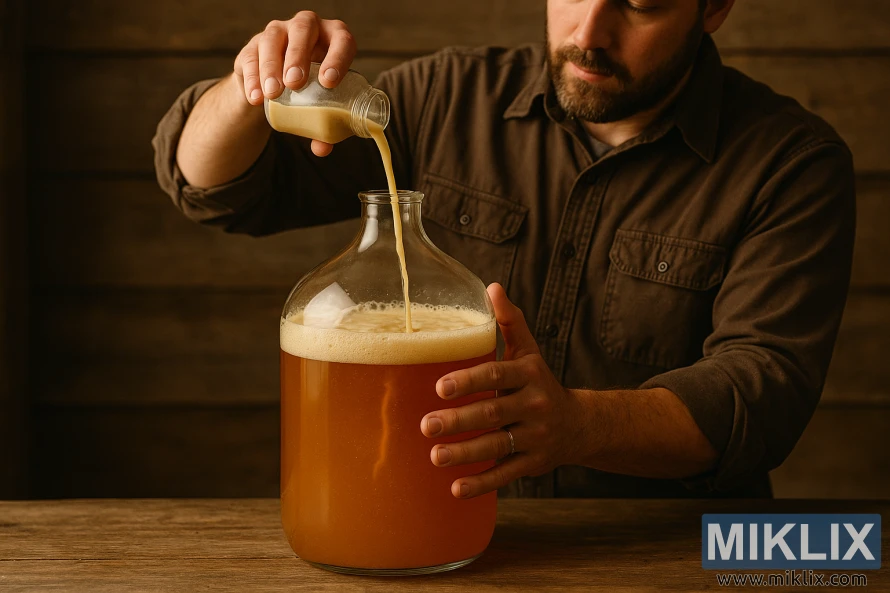
Troubleshooting Common Issues with Wyeast 1056 Fermentations
When brewing with Wyeast 1056, start by checking the starter and pitch practices. A sluggish starter 1056 often stems from an undersized starter, cool starter temperature, or impatience. Give the starter extra time, warm it slightly above main fermentation temperature, or step up once with a larger starter instead of repeated manipulations.
Long lag times sap confidence and yeast vitality. Common causes include underpitching, poor oxygenation, cold wort, or stressed yeast. Long lag time remedies include increasing pitch rate with extra packs or a bigger starter, improving aeration at high krausen, and ensuring the wort temperature sits in the yeast’s preferred range before pitching.
Off-flavors 1056, such as peppery phenols or fruity esters, usually point to temperature swings or rushed fermentations. Keep fermentation steady, avoid aggressive temperature ramps, and match pitch rate and oxygenation to the gravity. Proper control reduces spice and ester production while preserving the strain’s neutral profile.
Clarity problems relate to Wyeast 1056’s medium-low flocculation. Fixes include prolonged cold conditioning, giving the beer time to drop bright, or using filtration if you need clarity sooner. Patience often yields better chill haze resolution than chemical fining.
- Limit starter step-ups to lower infection risk and maintain sanitary technique when harvesting or repitching yeast.
- Rely on gravity readings, not just visual cues, to judge fermentation progress and final attenuation.
- When comparing batches, use blind tasting to determine if yeast-driven differences are meaningful versus recipe variation.
For practical troubleshooting Wyeast 1056, document pitch rates, starter size, oxygenation method, and fermentation temperatures. That log helps spot patterns when sluggish starter 1056 or off-flavors 1056 recur. Apply long lag time remedies early to avoid extended fermentations and keep your beer on schedule.
Conclusion
Wyeast 1056 stands out as a clean, versatile Chico-family yeast. It allows malt and hops to take center stage. With medium-low flocculation and 73–77% attenuation, it's ideal for American ales, pale ales, and British-inspired styles. Its reliability makes it a top choice for a house strain.
For optimal results with 1056, use tools to calculate starter sizing. Control fermentation temperature to reduce esters. Adequate oxygenation shortens lag time. Proper pitch rates and gentle temperature management are key, often more than genetics.
Summary Wyeast 1056: manage starters, temperature, and oxygenation. Allow time for conditioning or filtration for bright clarity. Brewers following these steps will enjoy a neutral, predictable profile. This highlights the recipe's components over the yeast itself.
Further Reading
If you enjoyed this post, you may also like these suggestions:
- Fermenting Beer with Fermentis SafLager S-189 Yeast
- Fermenting Beer with Lallemand LalBrew Voss Kveik Yeast
- Fermenting Beer with CellarScience Hornindal Yeast
